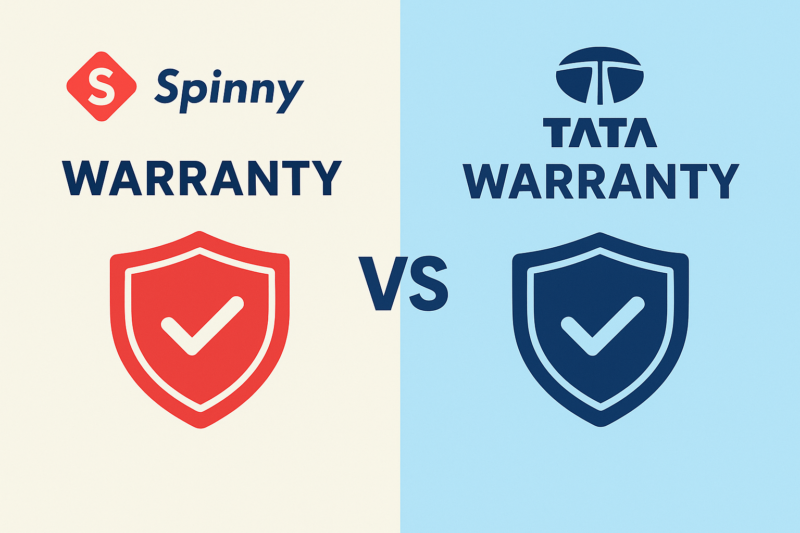CNG has emerged as a key alternative to conventional fossil fuels, notably in countries like India, where increasing air pollution and fuel prices have become a significant concern. This natural gas is not only a greener alternative to petrol and diesel, but also helps vehicles achieve higher fuel economy with lower emissions.
Before you explore options, learn everything there is to know about this fuel – the full form of CNG, its properties in detail, its development over the years, and its benefits.
What is CNG?
CNG is a natural fuel source produced by the compression of natural gas, primarily methane (CH4), to less than 1% of the total volume at standard atmospheric pressure. Such compression occurs typically at a pressure of 3000 to 3600 pounds per square inch.
CNG remains gaseous even after compression, unlike the liquefied natural gas (LPG), which is cooled to very low temperatures to become liquid. In its natural state, it is colorless, odorless, and non-corrosive. These properties make it attractive for various applications, essentially as a fuel source for vehicles, industrial processes, and heating.
CNG is stored in high-pressure cylinders when used in vehicles. The gas feeds into an engine that mixes it with air in the combustion chamber. This mix is ignited with spark plugs, which give off energy.
CNG Full Form and Meaning
The CNG full form stands for Compressed Natural Gas. It is composed of methane gas, which, when combined with air and introduced into your engine’s combustion chamber, generates engine power just like gasoline does.
Compressed
The “compressed” term in CNG full form refers to reducing the volume of natural gas under high pressure. This compression is important because it allows a large energy amount to be stored in a relatively small volume, making it practical for use in a vehicle. The compression process typically reduces the gas to about 1% of its volume at standard atmospheric pressure.
Natural
The “natural” term in CNG’s full form indicates that the gas used is of natural origin and extracted from underground deposits. Natural gas was formed years ago from the remains of plants and animals buried under layers of sediment. It’s considered a fossil fuel, but it’s considered cleaner than other fossil fuels.
Gas
Even after compression, CNG stays in gaseous form. This is the main difference between other fuel forms, such as LPG or LNG, which exist and are transported in liquid form.
Properties of Compressed Natural Gas

Understanding the properties of CNG is crucial for knowing its uses and benefits. Here are all the CNG properties you must know:
1. Composition
CNG mainly comprises methane (CH4), about 85-95% of the blend. A small proportion of ethane, propane, butane, and carbon dioxide make up the remaining percentage.
2. Energy Density
CNG has a lesser energy density than gasoline or diesel. At 3600 psi, its energy density remains at around 9MJ/L, as against about 34MJ/L for gasoline. This means that more CNG has to be used to provide the same amount of energy as these conventional fuels. However, its high-pressure storage increases its energy density, making it quite viable for vehicle applications.
3. Flammability
CNG has a high flammability rate, with the ignition temperature at approximately 540°C. The flammability ranges of this gas lie between 5% and 15% by volume in air. While this property makes it an adequate fuel, it also calls for lots of care during handling and storage.
4. Emissions
Compared to petrol or diesel fuel, CNG burns with much fewer emissions. It produces less CO2, CO, NOx, and particulate matter. It is suggested that on CNG, carbon monoxide could be reduced by as much as 70%, nitrogen oxides by up to 40%, and carbon dioxide by approximately 25% compared to petrol.
5. Odor
Although it is odorless in its pure state, an odorant is added to this natural gas for safety achieved via leak detection. It’s usually represented by a sulfur-containing compound called mercaptan, and deforming natural gas gives it a smell capable of detecting a leak.
6. Safety
CNG weighs about 0.6 specific gravity, which is lighter than air. Hence, in the event of a leakage, it spreads out very quickly into the atmosphere, unlike liquid fuels, which settle at ground level, thereby avoiding fire or explosion hazards.
7. Octane Rating
CNG has a high-octane rating of 130, while the premium petrol is 87-93. An octane rating this high allows for higher engine compression ratios, which would be more efficient and perform better.
History of Compressed Natural Gas
The CNG history in India symbolically encapsulates the country’s struggle to combat rising air pollution and significantly reduce reliance on expensive imported oil. Here is a detailed timeline of events regarding the history of CNG in India:
- Early 1990s: In India, compressed natural gas was first used in a test program between 1991 and 1992. The concept of using CNG as a vehicle fuel originated in India. This was mainly in response to growing air pollution concerns in large cities, particularly Delhi, which was among the world’s most polluted cities.
- 1998: In India’s landmark ruling, the Supreme Court of India ordered the running of public transport vehicles in Delhi on CNG to mitigate the acute problem of air pollution prevalent in Delhi. This was the turning point for the adoption of CNG in India.
- 2001: Delhi was the first city in India to adopt large numbers of CNG-driven buses. Before the end of the year, more than 1,000 buses and 10,000 auto-rickshaws ran on CNG in the city.
- 2002-2005: With the success of the CNG initiative in Delhi, other metropolises have started introducing this fuel. Mumbai began its conversion of public transport to CNG in 2002, while this fast-spreading initiative has embraced Ahmedabad, Pune, Lucknow, and other centers.
- 2006: Thereafter, the National Green Tribunal was established, which played a prime role in promoting the use of CNG throughout India with various judgments and directives.
- 2010s: The Indian government started aggressive marketing of CNG given its twin aims of reducing reliance on imported oil and reducing pollution. Many cities in India began setting up mechanisms for CNG.
- 2016: The government of India launched the “Gas4India” campaign to promote the consumption of natural gas, including CNG, across various sectors of the economy.
- 2020 onwards: The Indian government has been trying to increase the adoption of CNG, including in private vehicles, amid an increasing focus on reducing the emission of gasses from vehicles. Given this, many car manufacturers have started offering CNG variants of their popular models.
The government now has set an ambitious target to boost the share of natural and greener gas in India’s energy from 6.7 % in 2020 to 15 % by 2030.
Benefits of CNG You Must Know
CNG is as good as any conventional fuel like petrol and diesel and rather more advantageous. Following are the reasons for its increasing popularity, elaborated more:
1. Cost-Effective
Compared to petrol or diesel in India, CNG is very affordable, which makes it economically very attractive to vehicle owners. The cost of CNG in Delhi as of August 2024 is around ₹75.09 per kg, and that of petrol is around ₹94.72 per liter. These price differences alone infuse substantial savings.
CNG variants are more fuel-efficient than the same petrol variant. There is a significant mileage difference between the petrol car and CNG car. CNG engines are subjected to far less carbon deposition, which, after some time, is known to add to the maintenance cost.
2. Eco-friendly
CNG burns much cleaner than petrol or diesel, creating fewer harmful combustion by-products. This will make it an excellent choice to improve urban air quality and lower the transport sector’s carbon footprint. Here is the breakup of the reductions in emissions:
- Carbon Monoxide (CO): CNG can cut CO emissions by as much as 70% over petrol. Carbon monoxide (CO) is an extremely poisonous greenhouse gas that can cause health problems even in small concentrations.
- NOx: CNG can cut NOx by as much as 40%. NOx, that is, nitrogen oxides, reacts with other chemicals in the atmosphere, resulting in smog and acid rain.
- Carbon Dioxide CO2: CNG produces about 20-25% less CO2 than petrol. Carbon dioxide (CO2), emitted from petrol cars, is a greenhouse gas that majorly contributes to global warming.
- Particulate Matter: Almost no particulate matter is produced from cars running on CNG. Particulate matter is generally considered one of the central air pollutants in urban areas and is known to be a severe respiratory hazard.
Also, CNG will not contaminate soil/water in case of any spillage as it evaporates and disperses quickly into the air.
3. Improved Engine Life
These very clean-burning qualities of CNG help the vehicle’s engine and the environment. Here’s how:
- Reduced Carbon Deposits: CNG doesn’t leave behind carbon deposits in the engine, which can help maintain engine efficiency and power output over time.
- Less Oil Contamination: CNG does not mix or dilute the engine oil, thereby retaining the lubricating properties of the oil for more extended periods.
- Higher Octane Rating: Compared to petrol, with an octane rating of 87-93, CNG has a high octane rating of approximately 130. This means that CNG could support a higher compression ratio in the engine and, hence, provide more efficiency and better performance.
- Less Wear and Tear: Due to the clean burn of CNG, the engine components wear down less and may even run for a bit longer.
CNG Uses
The versatility of CNG has led to its adoption across various sectors:
Transportation
CNG is widely popular in transportation for improving engine performance, affordability, and availability. The CNG uses in transportation is spread across:
- Public buses and taxis
- Private vehicles (cars and two-wheelers)
- Commercial fleets and delivery vehicles
Industrial Applications
Besides transportation, the CNG is also popularly used in industrial applications. The CNG uses in industrial applications include:
- Power generation
- Manufacturing processes requiring heat
Domestic Use
CNG is widely used for domestic purposes, which includes:
- Cooking fuel (when piped directly to homes)
- For heating, in some regions
Agriculture
There are several CNG uses applicable in agriculture that are advantageous for the environment and the economy. Here are a few important applications:
- Powering irrigation pumps
- Crop drying
CNG Full Form, Details, History: Summary
Compressed Natural Gas is an emerging substitute for traditional fuels. More particularly, it is for cities with increasing levels of air pollution and rising fuel prices. As its whole form goes, Compressed Natural Gas wordly explains the nature and benefits it offers.
With economic and environmental benefits, the role of CNG will certainly rise in India’s transport sector in the coming times. However, with any technology, the pros and cons are necessary to keep in mind before making a decision.
FAQ’s
Q. What is the complete form of CNG?
CNG stands for Compressed Natural Gas. It is natural gas that is compressed to less than 1% of its total volume at standard atmospheric pressure.
Q. Is CNG Safer Than Petrol?
CNG is generally a much safer fuel than petrol. It has a high-temperature rating, making it quite hard to ignite. If there happens to be any leakage, it rises and disperses in air since it’s a gas. In the case of petrol, it would spread on the floor, thus increasing the chances of catching fire.
Q. Can any car run on CNG?Most petrol cars can run on CNG if fitted with a CNG kit. Other car manufacturers also provide factory-fitted CNG variants for some popular models.
Q. What are the disadvantages of a CNG car?
The drawbacks to CNG include reduced boot space due to the CNG cylinder, probable lower power output than petrol engines, and refueling more frequently due to lower energy density. Also, there may be limited stations for refilling CNG in some places.
Q. How often should the CNG cylinders be replaced?
CNG cylinders in vehicles must be replaced or recertified every 3 years or 2 lakh kilometers, whichever comes earlier. This becomes necessary to ensure that the high-pressure cylinder remains safe and integral.



